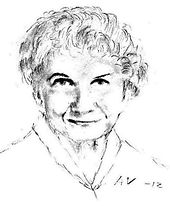The moons of Jupiter

The moons of Jupiter (in the original The Moons of Jupiter , 1977/1982) is a short story of the Canadian author Alice Munro as facts change, in which it comes to be.
action
The story is about Janet visiting her old father in the hospital where she drove him to the emergency room. Janet stays with one of her daughters, misses the other and visits the planetarium , among other things , where she discovers that some facts have changed since she was in school. When she took a quiz about the moons of Jupiter with her father, whose days are numbered, he especially had something to say about the name of the moon Ganymede . The next afternoon it's a museum's turn, and then Janet is on her way to the hospital again. This is how the story ends.
analysis
The story consists of seven sections that are not numbered. The shortest section, the last, is barely a page, the longest is four pages. A first-person narrator jumps back and forth in the chronology. In the collection Alice Munro's Best. Selected stories (Toronto 2008) the story in English has a length of 17 pages.
In this story, words are more than just mirrors for things or containers for thoughts and skepticism regarding language and representation is expressed in a highly stylized form. At the same time, the real is very present, such as dying. Munro demonstrates in this story that the power of language on the one hand can create connections and pathos, but on the other hand it cannot do anything against the limited possibilities of describing the world. Ultimately, this leads to a failure of consciousness because it cannot fully understand the world, the other and the self, said Tim McIntyre in his analysis of this work.
Professional success must first be achieved and then one should apologize for it, Munro lets her character Janet reflect on an expected judgment of her father. Munro's characters would also be punished if they were successful - for example as a writer in The Moons of Jupiter , according to Margaret Atwood in 2013 in The Guardian , in her statement on the Nobel Prize for Alice Munro.
On the occasion of the first translation into German, Manuela Reichart noted in 1987 in the features section of the weekly magazine Zeit that the stories collected in the volume Die Jupitermonde had a common theme, namely the search of the aged protagonists for continuities in the biography of their parents and how they dealt with their own memories. This is particularly true of the eponymous story.
Editions and versions
The Jupiter Moons was first published on May 22, 1978 in The New Yorker and in 1982 as the cover story of the author's fourth collection of the same name ( The Moons of Jupiter ). “The Moons of Jupiter” is one of those stories with which Munro achieved his international breakthrough around 1980. In 1996, 2004, 2006 and 2008 the story was again included in the author's collections. The German-language edition of the collection from 1982 appeared in 1986 and again in 2002.
In the version published in The New Yorker , Janet is not a writer but a painter. For the second version, “measurement” was added in the fifth section (here in italics): “I saw how the forms of love might be maintained with a beloved person but with the love in fact measured and disciplined, because you have to survive.” Against A sentence is continued differently at the end of the same section. Instead of: “Moonless Mercury rotating three times while circling the sun twice; an old arrangement, not as satisfying as the old one, for once "(1978) is the comparison in the second version:" not as satisfying as what they used to tell us - that it rotated once and it circled the sun. "( 1982)
literature
- McIntyre, Tim, 'The way the stars really do come out at night': the trick of representation in Alice Munro's "The Moons of Jupiter", in: Canadian Literature / Littérature canadienne (200) 2009, 73-88.
- Coral Ann Howells, Star Maps and Shifting Perspectives: Alice Munro's "The Moons of Jupiter", in: "Union in Partition": Essays in Honor of Jeanne Delbaere , Debusscher, Gilbert (ed. And biography); Maufort, Marc (ed.), Liège, Belgium: L3 – Liège Language and Literature; 1997, pp. 173-80.
- Ajay Heble, The tumble of reason. Alice Munro's discourse of absence , University of Toronto Press, Toronto, Ontario, 1994, ISBN 0-8020-0617-5
- WH New, "The rowboat, the wheel, and the galloping oilcan", in: Australian & New Zealand Studies in Canada (12) 1994, 64-72. (On The Moons of Jupiter )
- Magdalene Redekop, Mothers and Other Clowns , London: Routledge, 1992, ISBN 0-415-01097-7 , ISBN 0-415-01098-5
- Ildikó de Papp Carrington, Controlling the Uncontrollable. The Fiction of Munro . DeKalb: Northern Illinois UP, 1989, ISBN 0-87580-149-8
Individual evidence
- ↑ Ajay Heble, The tumble of reason. Alice Munro's discourse of absence , University of Toronto Press, Toronto, Ontario, 1994, ISBN 0-8020-0617-5 , p. 127.
- ^ A b c Tim McIntyre, “The Way the Stars Really Do Come Out at Night”. The Trick of Representation in Alice Munro's “The Moons of Jupiter” , in: Canadian Literature 200 / Spring 2009, pp. 73-88.
- ↑ Alice Munro: an appreciation by Margaret Atwood , by Margaret Atwood, The Guardian , October 11, 2013
- ↑ Manuela Reichart: With skin and hair. Canadian narratives. "The moons of Jupiter" by Alice Munro , Die Zeit, August 14, 1987.
- ^ Carol L. Beran, The Luxury of Excellence: Alice Munro in the New Yorker , in: The rest of the story. Critical essays on Alice Munro , edited by Robert Thacker, ECW Press, Toronto 1999, ISBN 1-55022-392-5 , pp. 204-231, footnote 1, p. 227.
- ^ List of Alice Munro's Short Stories in the English language Wikipedia